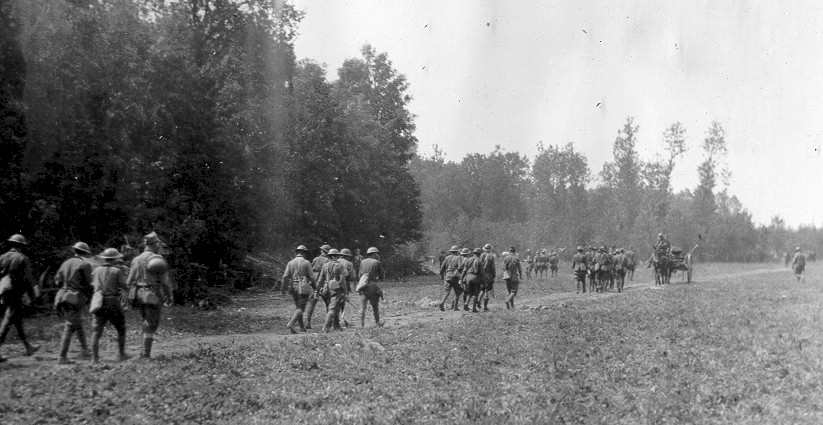The Armistice, November 11th 1918

Soldiers start the long march home (photo shows a burial detail from the U.S. 42nd Division, July 30th 1918).
Image from ‘Mortuary Affairs’, www.en.m.wikipedia.org
The deteriorating German situation led to the abdication of Kaiser Wilhelm on November 9th 1918. An armistice was drawn up with effect from November 11th at 11 a.m. From this moment, servicemen had to adjust to the end of the war and their return to civilian life. Despite the guns being silenced, deaths continued at the front in casualty clearing stations and at base hospitals. The influenza pandemic was a new, terrible hazard resulting in additional loss of life abroad and at home.
The initial reaction to the Armistice in theatres of war was mixed. Colonel Thomas Gowenlock, an intelligence officer in the American 1st Division, based at Le Gros Feux, described what happened where he was posted:
But at the front there was no celebration. Many soldiers believed the Armistice only a temporary measure and that the war would soon go on. As night came, the quietness, unearthly in its penetration, began to eat into their souls. The men sat around log fires, the first they had ever had at the front. They were trying to reassure themselves that there were no enemy batteries spying on them from the next hill and no German bombing planes approaching to blast them out of existence. They talked in low tones. They were nervous.
After the long months of intense strain, of keying themselves up to the daily mortal danger, of thinking always in terms of war and the enemy, the abrupt release from it all was physical and psychological agony. Some suffered a total nervous collapse. Some, of a steadier temperament, began to hope they would someday return to home and the embrace of loved ones. Some could think only of the crude little crosses that marked the graves of their comrades. Some fell into an exhausted sleep. All were bewildered by the sudden meaninglessness of their existence as soldiers.” (source: http://www.eyewitnesstohistory.com/armistice.htm)
The previous pages outline circumstances in which servicemen from one village in England lost their lives in the Great War. The incidents described reflect the conduct of the war and typical traumatic experiences suffered by millions on both sides. The estimated casualty figures for British Forces vary over time and according to different definitions and methods of calculation. However, it is generally accepted that just under a million from the Armed Forces lost their lives (including those serving with the British Army, Royal Navy, RFC/RAF, from U.K. and Commonwealth countries) and over two million others were wounded in the Great War. German servicemen deaths are estimated at just over two million.
Author: Rosemary Collins
For further information on WWI military units, battles and strategies, go to:
